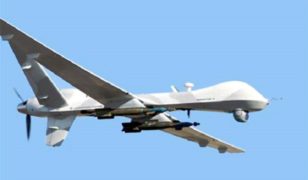Worldwide UAV market will total $77 billion during coming decade, Teal predicts

Teal Group analysts, in their 2014 Unmanned Aerial Vehicles (UAVs) integrated market study, estimate that UAV spending will nearly double over the next decade from current worldwide UAV expenditures of $5.7 billion annually to $9.9 billion, totaling just over $77 billion in the next 10 years.
“The UAV market continues to evolve and become an increasingly global market,” said Philip Finnegan, Teal Group’s director of corporate analysis and an author of the study.
“And our coverage of the civil UAV market continues to grow with each annual report, mirroring the gradual increase in the civil market itself,” said Finnegan. “Our 2014 UAV study calculates the UAV market at 89% military, 11% civil cumulative for the decade, with the numbers shifting to 86% military and 14% civil by the end of the 10-year forecast.”
“The Teal Group study predicts that the U.S. will account for 65% of the worldwide RDT&E spending on UAV technology over the next decade, and 53% of the procurement,” said Teal Group senior analyst Steve Zaloga, another author of the study.
The 11th edition of the sector study, World Unmanned Aerial Vehicle Systems, Market Profile and Forecast 2014, examines the worldwide requirements for UAVs, including UAV payloads and companies, and provides 10-year forecasts by country, region, and classes of UAVs.
UAV Payloads
The 2014 study provides 10-year funding and production forecasts for a wide range of UAV payloads, including Electro-Optic/Infrared Sensors (EO/IR), Synthetic Aperture Radars (SARs), SIGINT and EW Systems, and C4I Systems, forecast to double in value from $2.8 billion in FY14 to $5.6 billion in FY23, according to Dr. David Rockwell, author of the electronics portion of the new study.
“The overall UAV electronics market will continue to be the world’s fastest-growing aerospace payload market, but not through continued growth of ‘the usual suspects’ from the past decade,” said Dr. Rockwell. “Instead,” he added, “new sensor programs for current and future air vehicles will result in more unexpected growth spurts and losses. For the 2014 study we have added a number of speculative new programs in the out-years. Wise companies will plan today for growth tomorrow.”
UAV companies
The study also includes a UAV Manufacturers Market Overview that reflects the worldwide UAV market “again continuing as one of the prime areas of growth for defense and aerospace companies,” said Finnegan. The new study covers more than 40 U.S., European, South African and Israeli companies, and reveals the fundamental reshaping of the industrial environment as UAV technology proliferates worldwide.
Google, Facebook and Amazon
As prime contractors and small companies compete in the dynamic UAV market, they are adopting widely different strategies. “Our overview tracks these widely varying approaches being taken by these key companies, ranging from outright acquisitions to teaming arrangements and internal development of new UAV systems,” said Finnegan.
“It shows how companies worldwide are responding to the growth of the UAV market and the extent to which a new breed of technology companies, such as Google, Facebook and Amazon, are working to position themselves in the UAV market.”
The 2014 edition includes UAV market forecast spreadsheets, permitting data manipulation and offering a powerful strategic planning mechanism.






